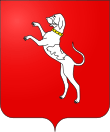House of Canossa
The House of Canossa, also known as the Attonids, was an Italian noble family, holding the castle of Canossa, from the early tenth to the early twelfth century.
| House of Canossa Italian: Casa Canossa | |
|---|---|
| Noble house | |
 | |
| Country | Holy Roman Empire |
| Founded | Ca. 910 |
| Founder | Sigifred of Lucca |
| Final ruler | Sigifredo of Canossa |
| Titles |
|
| Estate(s) | Canossa Castle (seat) |
| Deposition | 1115 |
Of a family from Lucca, Sigifred built the castle at Canossa around 940. The lords were soon using the title comes (count) and had received many other Tuscan counties from the Holy Roman Emperors. Guastalla in 991, Parma, Piacenza, Bergamo, and Cremona in 984, Brescia in 980, Mantua had been obtained in 977, Modena, Carpi, and Reggio in 962, and Lucca even earlier. In 1027, the March of Tuscany was granted to Boniface and, in 1100, the March of Verona to Matilda, known as La Gran Contessa. The details of the relations between Sigifred's sons Sigifred II and Adalbert Atto are unknown and the latter appears in Canossa in time to give refuge to Queen Adelaide when she was fleeing Berengar II and Willa in 955.
The Bishop of Arezzo from 1023 to 1036 was a member of the house: Tedald, sponsor of Guido of Arezzo.
Counts of Canossa
- Prangarda of Canossa
- Adalbert Atto of Canossa
- Sigifred of Lucca
- Adalbert Atto of Canossa
- Tedald of Canossa
- Boniface III of Tuscany
- Frederick of Tuscany
- Matilda of Canossa